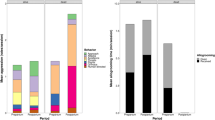Researchers have not studied vomiting that is not associated with pathological behavior in nonhuman primates. Scientists generally assume that vomiting provides protection by ejecting toxins from the body, but the explanation is not fully supported by the literature. We report on 163 instances of vomiting from 2 groups of free-ranging bonnet macaques in southern India. The macaques routinely reingested their vomit. The reingestion was unlike that in abnormal behavior of both humans and nonhuman primates. We suggest that the tendency to hoard food in their cheek pouches explains why they reingested the vomit.

Similar content being viewed by others
REFERENCES
Baker, K. C., and Easley, S. P. (1996). An analysis of regurgitation and reingestion in captive chimpanzees. Appl. Anim. Behav. Sci. 49: 403–415.
Ball, T. S., Hendricksen, H., and Clayton, J. (1974). A special feeding technique for chronic regurgitation. Am. J. Ment. Defic. 78: 486–493.
Blum, R. H., Heinrichs, W. L., and Herxheimer, A. (2000). Nausea and Vomiting: Overview. Challenges, Practical Treatments and New Perspectives. Whurr, London.
Davis, C. J., Harding, R. K., Leslie, R. A., and Andrews, P. L. R. (1986). The organization of vomiting as a protective reflex: A commentary on the first day’s discussions. In Davis, C. J., Lake-Bakaar, G. V., and Grahame-Smith, D. G. (eds.), Nausea and Vomiting: Mechanisms and Treatment. Springer-Verlag, Berlin, pp. 65–75.
Glander, K. E., and Rabin, D. P. (1983). Food choice from endemic North Carolina tree species by captive prosimians (Lemur fulvus). Am. J. Primatol. 5: 221–229.
Johnson, E. (2000). Food-neophobia in rhesus macaques (Macaca mulatta) [dissertation]. University of Georgia, Athens, GA.
Johnston, J. M., Greene, K. S., Vazin, T., Winston, M., and Rawal, A. (1990). Effects of food consistency on ruminating. Psych. Rec. 40: 609–618.
Kay, R. F. (1984). On the use of anatomical features to infer foraging behavior in extinct primates. In Rodman, P. S., and Cant, J. G. H. (eds.), Adaptations for Foraging in Nonhuman Primates. Columbia University Press, New York, pp. 21–53.
Lindburg, D. (1971). The rhesus monkey in north India. In Rosenblum, L. A. (ed.), Primate Behavior: Developments in Field and Laboratory Research, Vol. 2. Academic Press, New York, pp. 1–106.
Lukas, K. E. (1999). A review of nutritional and motivational factors contributing to the performance of regurgitation and reingestion in captive lowland gorillas (Gorilla gorilla gorilla). Appl. Anim. Behav. Sci. 63: 237–249.
Mazzeo, S., Espelage, D., Sherman, R., and Thompson, R. (2003). Trends in eating disorder symptomology in an outpatient clinic: 1988–1998. Eating Behav. 42: 211–220.
Milton, K. (1984). The role of food-processing factors in primate food choice. In Rodman, P. S., and Cant, J. G. H. (eds.), Adaptations for Foraging in Nonhuman Primates. Columbia University Press, New York, pp. 249–279.
Murray, P. (1975). The role of cheek pouches in cercopithecine monkey adaptive strategy. In Tuttle, R. H. (ed.), Primate Functional Morphology and Evolution. Mouton, The Hague, pp. 151–194.
Rast, J., Ellinger-Allen, J. A., and Johnston, J. M. (1985). Dietary management of rumination: Four case studies. Am. J. Clin. Nutr. 42: 95–101.
Shinagawa, K., Konuma, H., Sekita, H., and Shunji, S. (1995). Emesis of rhesus monkeys induced by intragastric administration with the HEp-2 vacuolation factor (cereulide) produced by Bacillus cereus. FEMS Microbiol. Lett. 130: 87–90.
Struhsaker, T. T. (1967). Auditory communication among vervet monkey (Cercopithecus aethiops). In Altmann, S. A. (ed.), Social Communication Among Primates. University of Chicago Press, Chicago, pp. 281–324.
Walker, P., and Murray, P. (1975). An assessment of masticatory efficiency in a series of anthropoid primates with special reference to the colobinae and cercopithecinae. In Tuttle, R. H. (ed.), Primate Functional Morphology and Evolution. Mouton, The Hague, pp. 135–150.
ACKNOWLEDGMENTS
Grant No. INT-9901439from the National Science Foundation to M. Cooper supported the research. We thank Mewa Singh, M. A. Anand, M. S. Chaitra, H. N. Kumara, A. K. Sharma, and H. S. Sushma for their assistance in the field. A. Galloway, E. Addessi, and 4 anonymous reviewers provided valuable feedback on an earlier version of the manuscript, including the suggestion that vomiting may serve a toxic ejection function that produces false alarms with harmless food. We thank the Tamil Nadu Forest Department for permission to conduct research in the Anaimalai Hills and the management of Waterfall Tea Estates for logistical support. The research project complied with Indian Law and was approved by the University of Georgia Institutional Animal Care and Use Committee.
Author information
Authors and Affiliations
Corresponding author
Rights and permissions
About this article
Cite this article
Johnson, E.C., Hill, E. & Cooper, M.A. Vomiting in Wild Bonnet Macaques. Int J Primatol 28, 245–256 (2007). https://doi.org/10.1007/s10764-006-9085-5
Published:
Issue Date:
DOI: https://doi.org/10.1007/s10764-006-9085-5




